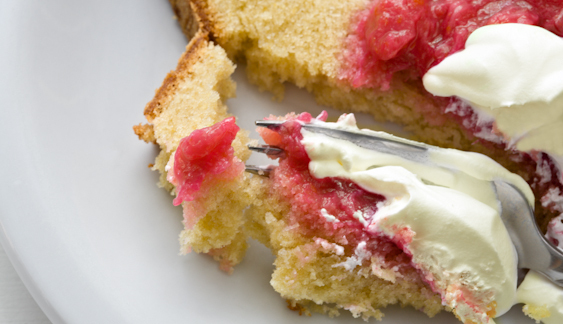Rhubarb Compote

introduction
If you live in a northern clime, you’ll know spring is coming when the rhubarb stalks and leaves make their annual pilgrimage above ground, shooting gloriously up through the snow. A dramatic gesture, to be sure, but no one ever accused rhubarb of conventional behavior. Stubbornly independent, rhubarb will return to a garden year after year ahead of the other flora, even if it has been neglected. A vegetable, it is handled like a fruit, but it came to the kitchen by way of the apothecary. Stalky and astringent—downright puckery when raw (no wonder it was first used as a medicine)—rhubarb succumbs to heat and sugar like a baby. Its bright, bracing tartness tames lush fruits like strawberries or raspberries—and rhubarb offers a bit of its own thickening magic, too. Many cooks try to woo rhubarb with warm spices and vanilla, but rhubarb doesn’t fall for that sort of flirtation. Instead, give it a taste of its own medicine in the form of citrus juice and peel. (Rhubarb likes to tip a bit of red wine, on occasion, too.)
This little compote we’ve made drapes beautifully over a slice of Colonial Cornmeal Pound Cake and spoons equally well with our Carolina Gold Rice Pudding. And were it simply layered with whipped cream, it would be anyone’s fool.
Rhubarb doesn’t hang around for the hot months, so grab it in the spring and early summer.
Cooking Remarks
Anatomically, rhubarb stalks are much like celery stalks—celery in a ravishing hue. Recipes may call for peeling them, but we hate to lose that tropical-sunset stain. Trim the stalks, then slice each one lengthwise into ¼-inch thick strips—2 or 3 strips, depending on how thick the rhubarb stalk is—and then crosswise into dice.
In a saucepan on the stove top, rhubarb breaks down pretty quickly. Sometimes a little too quickly. If you overstir while it is cooking or cook it too long, rhubarb will degrade into pink mush. To counter this tendency, we add sugar and lemon juice to the rhubarb and let the mixture macerate before introducing the heat. The sugar and the acid from the citrus “burn” the vegetable fibers, inducing them to give off liquid. Thus, the cooking begins very gently, before the bottom of the pan even touches the burner.
equipment mise en place
For this recipe, you will need a rasp-style grater/zester, a medium heavy-bottomed nonreactive saucepan, and a wooden spoon.
-
-
1pound crisp, richly hued rhubarb stalks, washed, trimmed, and cut into dice (about 3½ cups)
-
3.5ounces (½ cup) sugar, plus additional as needed
-
3tablespoons juice from 1 large, juicy lemon
-
Pinch of fine sea salt
-
1½tablespoons finely grated lemon or orange zest, or a combination of the two
-
-
Turn the rhubarb, sugar, lemon juice, and salt into a medium heavy-bottomed nonreactive saucepan and stir with a wooden spoon to combine. Let stand until the rhubarb exudes some liquid, 15 to 20 minutes.
-
Set the saucepan over medium heat and cook the rhubarb mixture, stirring occasionally, until the liquid begins to simmer gently, 5 to 7 minutes. The rhubarb pieces should be soft but still hang on to some of their shape. Off heat, stir in the citrus zest. Taste for seasoning; if you find the compote too tart, stir in up to 2 tablespoons sugar while it is hot. Transfer the compote to a nonreactive bowl, let cool to room temperature, and then cover and refrigerate until ready to use.